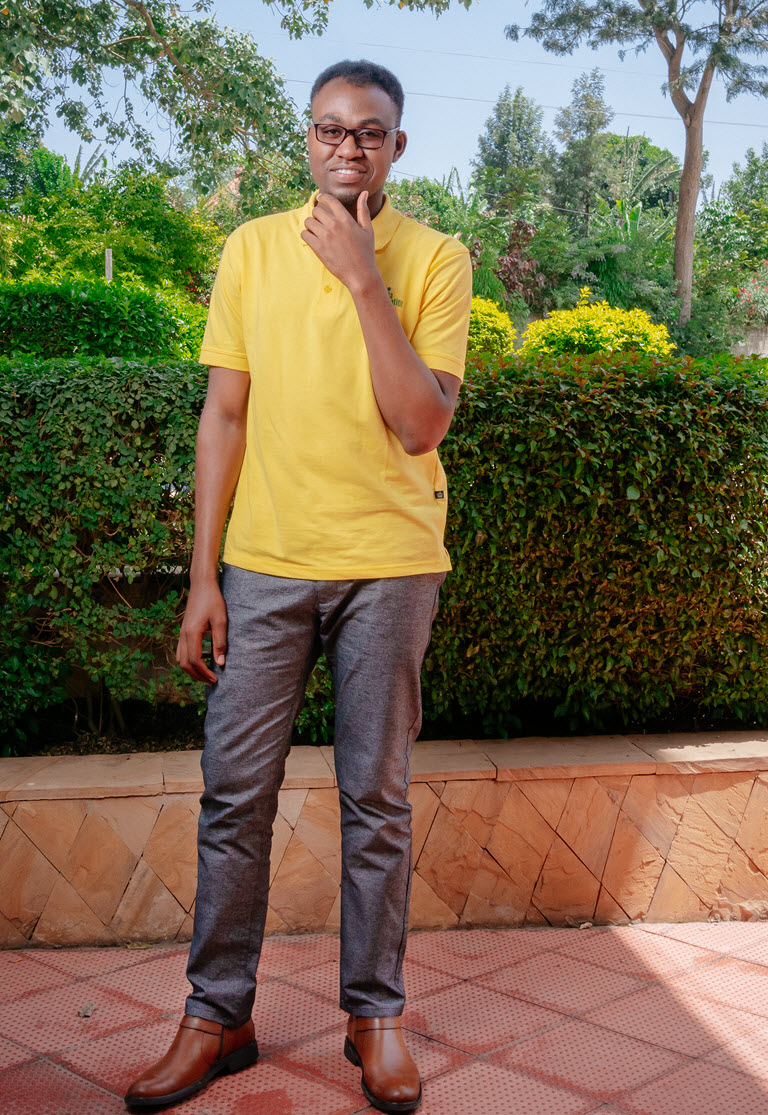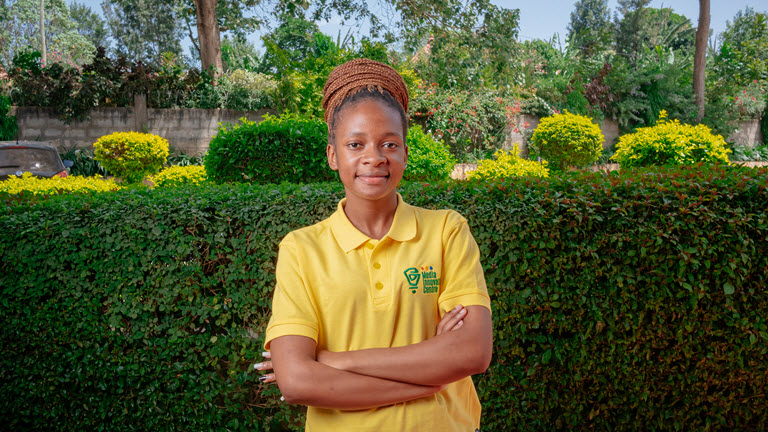The chances of meeting a medical graduate practising journalism are usually very slim, especially in Sub-Saharan Africa. But two Tanzanian physicians have broken away from that norm by inventing a start-up called Afyatoon. It uses visual art technology to tell compelling medical stories. They narrate to the EAST Site their experience and share their vision for the future.
At only 27 years, Edwin Ngula Luguku, is the CEO and founder of Afyatoon. Glory Charles Mlagwa, his counterpart, a lab technician and project manager, is even younger at 23.
But age doesn’t seem to be an obstacle for these two, who are part of the current Innovators-in-Residence (IiR) cohort, courtesy of the Media Innovation Centre (MIC).
Afya means health in Kiswahili, and toon is short for cartoon. As the name suggests, Afyatoon is a health-oriented organisation that uses animation to tell health stories on digital platforms such as YouTube, WhatsApp, and Instagram.
The two young innovators seek to carve a unique niche in Tanzania’s media industry. Of course, there are perils along the way, but the pair is young, exuberant, intelligent and eager to explore.
Humble beginnings
Intriguingly, their desire to tell medical stories was birthed while studying medicine-related campus courses.
Four professionals – all medics – and seven consultants also trained in medicine now make up Afyatoon.

“I’m an intern doctor in Dar es Salaam, but this initiative – telling medical stories through animation – began in 2018 through a project called Amka Kijana,” Edwin recounts. “We were trying to create content on HIV/Aids prevalence in Tanzania to create awareness, particularly for the youth,” he explains.
Amka Kijana would later morph into Afyatoon.
“From the little survey we did, we realised the problem lay in how the messages – about HIV/Aids – were being delivered,” Edwin further explains.
“We set out to make this (story-telling) educational and entertaining.” They did this by, for instance, looking at modalities; when talking about a specific parameter in HIV. “We also explored mental health and non-communicable diseases. So, from Amka Kijana, we formed Afyatoon.”
Partnering with health centres
Edwin says that as much as they are medics trying to explore journalism, the unique value proposition in their project hasn’t changed. They use animations, 3Ds and motion graphics to tell their impactful health stories.
Afyatoon has partnered with some hospitals to have their content relayed on screens in waiting areas of such facilities to reach a wider audience.
“We are utilising hospital waiting areas – where patients stay as they wait to see doctors. If it’s a cardiac-based hospital, we relay cardiac-based content. We’re innovating on modalities and tools used to give education,” Edwin says.
According to him, the response has been ‘satisfactory’, based on the content they are producing.
“We once did an online project on mental health called ‘Hold-My-Hand’, and we had a very high audience engagement,” Edwin proudly expounds, adding that the youth were particularly keen on being co-opted as content co-creators.
“We’ve also analysed audience perception of our content, which got high reviews and strong video preference, particularly comic videos,” he explains.
Learning curve
While acknowledging that they still have a long way to go, Edwin is optimistic that fine-tuning their start-up at the Innovators-in-Residence will make them better storytellers, content creators and even managers.
“This – innovators-in-residence – is new to us. Likewise, the concept of human-centred design is also new to us, but we need it if we are to attain sustainability.”
He said the IiR experience had exposed them to so many new things and that they were grateful for the tremendous support from coaches, trainers and community managers.
The duo is optimistic that the experience gathered will make them more skilled in project management as a media outlet.
At the MIC, they’ve also learnt other essential aspects of story-telling, including fact-checking. Edwin picks out two things that are already standing out as must-dos; experience learning about projects as a media outlet and working with other media innovators on fact-checking.
The pursuit of Media Viability

“In any project, we wish for two things: Attaining sustainability (media viability) through a media-based business model through Lean Canvas,” Edwin says. “And to see that the work here comes to reality,” he added, reckoning that this work is getting them into spaces they’d never imagined.
Edwin’s partner in the project, Glory, notes that she, too, is looking to gain journalistic skills from the IiR programme.
“All along, we’ve been doing this, not from a journalist’s point of view, but now we have the human-centred design, so we’re looking at the sustainability of the project into a health-based media – a major media house in Tanzania that deals with health content,” Glory says.
However, the Afyatoon duo notes that conceptualising and making their content commercially attractive remains their biggest challenge, a steep hill they hope to surmount soon.
The other major challenge, Edwin admits, is customer appreciation. They are not sure what kind of customers will pay for their content. To help overcome this challenge, they have lots of discussions with their coaches.
“Our users cannot be the ones to pay for production and dissemination. So the question about the best business approach, acquiring new skills, and time management is of the essence,” Edwin concludes.
 Isaac Swila
Isaac SwilaReport by Aga Khan University’s Media Innovation Centre analyses the country’s millennials and digital natives’ media consumption habits.
For the media to flourish, and the society to have free flow of accurate and verifiable information, journalists, the drivers in the passing of information are expected to be well grounded in laws and the legal aspect pertaining to the job, writes Alfred Ganzo.
Pitching provides numerous opportunities for your new or existing business ideas to be discovered and realized; and as Simon Mtabazi writes, some startups have become billion-dollar companies due to efffevie pitches
The success you achieve with your media startup business will heavily rely on your reputation as a trustworthy company, and as Nandi Mwiyombella writes, it will also open a new window for customers and potential investors.
That’s why I think today is such a great space for us to sit back and reflect on the questions that could help us shape the kind of journalism that we want to see in our local and global community.
The report specifically analysed eight major variables which include: newsroom structure and resources, media ownership and business models, organisational capacity, innovation culture, journalism culture, financial trends and results, content quality and COVID-19.
Mudi, in her role as Media Council of Kenya regional coordinator in charge of Mombasa(covering the entire coastal region), has found herself at the forefront in advocating and fighting to protect journalists’ rights, culminating in her being awarded for her peace efforts in the run-up and during the 2022 general elections in Kenya.
The 2022 general elections have been mentally draining for journalists, some of whom have had to stay on the campaign trail for over a year. Others have had to toy with the tough call of managing teams in the newsroom. East Site’s Isaac Swila and political writer Rawlings Otieno recount their experiences
What role did social media influencers play in the election? What voice did they give in political discourses during and around the election period? And to what extent did political candidates involve the influencers in marketing their manifestos to sway votes in their favour? East Site writer Steven Omondi unpacks the details
The media industry is experiencing enormous transformation as new digital trends emerge. With the vast opportunities that the digital space offers, media owners and content producers must deliberately adapt to how the audience consumes content.
With the increased Digital Technology at the palm of just anybody; there are a lot of information that distort whether deliberately or not highlighting the need of robust Fact0checking as Asha D. Abinallah explains
Is there a danger in media personalities having a vibrant social media presence? Assuming they have a massive media following, should they self-regulate and filter what they post? And when they engage with followers, should their opinions be taken as personal, or does it represent the journalist’s media house? East Site writer Isaac Swila explores
Media stakeholders are raising concerns over the lack of gender-inclusive reporting in East African newsrooms. They want concerted efforts to ensure more female journalists get equal opportunities like their male counterparts.
The partnership will also ensure that local content is curated and distributed to better optimize the product and meet the needs of Kenyan online users.
The news industry is constantly changing, and in the last few years, User Generated Content (UGC) has become a ubiquitous feature in news sourcing and packaging. However, media houses and journalists need to establish verification and credibility safeguards to avoid the misinformation trap.
Reporting on elections is, for many journalists, an opportunity to establish themselves as reliable political reporters. But the task comes with certain risks, particularly in the East African sub-region.
Stakeholders are now calling for concerted efforts, better planning and preparations for journalists before they are sent out on the field to cover Kenya’s high-stakes August 9 General Elections.
East Africa’s media grapples with a myriad of challenges whenever general elections approach. Not only do editors struggle with balancing the competing political interests, at times at the altar of professionalism, but individual journalists pay dearly, many suffering attacks in the course of their duties.
As Form One students settle into a new life in secondary school, this has also been a period of reflection. We have read tear-jerking and heart-warming stories of determined students who overcame many odds to get an education and how well-wishers came together in their aid.
There is renewed optimism in the Tanzanian media space following the ascension to power of President Samia Suluhu whose regime is keen to relax some of the laws deemed punitive to journalists and media houses
Uganda fell behind, whereas Kenya improved its press freedom ranking in the Reporters Without Borders 2022 Press Freedom Index. And after years of media freedom decline, Tanzania appears to be on the right track. But overall, media freedom activists say there is still work to be done.
A free and independent press is the cornerstone of any democracy and the foundation of economic success, mostly because through our free press, we’re able to hold the leadership to account.
To align with the changing times and stay relevant in the business, media houses are challenged to rethink their strategy and to adopt and understand obstacles and challenges they face towards rethinking and exploring alternative sources of revenue and on developing the digital strategy.
A team of young, Tanzanian tech-savvy communication professionals is dreaming big. It seeks to usher a new dawn in media business management in Tanzania by optimising employee output and offering consultancy to media businesses on how they can operate with a minimal budget but still attain their goals.
Bloggers and influencers have become an integral component of information sourcing across East Africa. The public uses blogs, privately run websites and social networks to crowdsource information from social networks, which they then publish and distribute. But it’s not all rosy for this group of content makers.
Did you know that in 2021 Kenyans watched less TV and spent more time on social media? Or that some Kenyans rely on family, friends, or even social media icons and bloggers as a source of news and information? These are some of the conclusions highlighted in the 2021 State of the Media Survey conducted by the Media Council of Kenya (MCK).
The effects of the Covid pandemic continue to change the world in ways we had not imagined possible. The media is going through a painful transformation to keep up with changing production, distribution and consumption habits. In East Africa, Uganda’s Media Challenge Initiative (MCI) recently hosted a panel discussion on Media Viability comprising experienced journalists from Television, Radio, Print and Online/Digital media to address lessons learned from the pandemic. East Site’s Moses Mutente attended the panel and compiled this article.
In this commentary, Uganda-based journalist Caleb Okereke shares deep personal insights into why media schools in East Africa must rethink their curriculum. He stresses the need for trainers to begin teaching media ownership to better equip journalism students for the dynamic and cutthroat job market by taking us through his journey as a journalism student and media owner.
For the second year running, a survey commissioned by the Media Council of Kenya shows that the trust level in Kenyan media has nosedived, raising fundamental questions on how media will play its watchdog role more so with landmark elections set for August 9. EAST Site writer Isaac Swila explores.
Legacy media is currently caught between a rock and a hard place — the Covid pandemic and the rise and proliferation of social media has hit revenues hard. Some say this could signal the end of news as we used to know it. However, Ugandan decorated journalist Ernest Bazanye believes the industry will survive and thrive, but not without a fight.